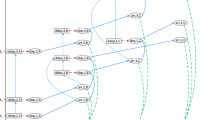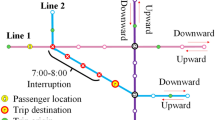Abstract
Disruption in urban rail services can severely affect passengers’ daily travel activities. Transit agencies and operators, besides providing reliable urban transit services and maintaining rail infrastructures, are also interested in developing effective and efficient disruption management strategies. This paper investigates the effect of information provision and contagion under train service disruption for typical disruption management strategies adopted by transit operators. A dynamic modelling framework is proposed for flow assignment within an integrated rail-bus transit network. Information-based user equilibrium, time-dependent line station waiting time estimation, and dynamic optimal travel path generation are integrated into the network loading procedure. A case study based on the Singapore public transit network is presented. Passenger evolution at selected bus stops around the disrupted train stations, the average time loss and the behavior of mode switch are analyzed under different levels of passenger information awareness. The computational results show the influence of information penetration rate and spread speed on the network performance and demonstrate the crucial role of information awareness in passengers’ travel behaviors during disruption. It also shows that our proposed methodology can comprehensively model the train service disruption in terms of the passenger behaviors, the disruption information contagion mechanism and the disruption effects, which support the public transit agencies to evaluate the system performance based on different information provision plans in order to enhance the disruption management.








Similar content being viewed by others
References
Adnan M, Pereira F, Azevedo C et al (2017) Evaluating disruption management strategies in rail transit using SimMobility mid-term simulator: a study of Singapore MRT North-East line. In: Transportation Research Board 96th annual meeting
Cadarso L, Marín Á, Maróti G (2013) Recovery of disruptions in rapid transit networks. Transp Res Part E Logist Transp Rev 53:15–33. https://doi.org/10.1016/j.tre.2013.01.013
Cats O, Jenelius E (2015) Planning for the unexpected: the value of reserve capacity for public transport network robustness. Transp Res Part A Policy Pract 81:47–61. https://doi.org/10.1016/j.tra.2015.02.013
Cepeda M, Cominetti R, Florian M (2006) A frequency-based assignment model for congested transit networks with strict capacity constraints: characterization and computation of equilibria. Transp Res Part B Methodol 40:437–459. https://doi.org/10.1016/j.trb.2005.05.006
Chan R, Schofer JL (2014) Role of social media in communicating transit disruptions. Transp Res Rec J Transp Res Board 118:145–151. https://doi.org/10.3141/2415-16
Daganzo CF, Sheffi Y (1977) On stochastic models of traffic assignment. Transp Sci 11:253–274. https://doi.org/10.1287/trsc.11.3.253
Dai X, Tu H, Sun L (2016) A multi-modal evacuation model for metro disruptions : based on automatic fare collection data in Shanghai, China. In: Transportation Research Board 95th annual meeting
De-Los-Santos A, Laporte G, Mesa JA, Perea F (2012) Evaluating passenger robustness in a rail transit network. Transp Res Part C Emerg Technol 20:34–46. https://doi.org/10.1016/j.trc.2010.09.002
Dijkstra E (1959) A note on two problems in connexion with graphs. Numer Math 1(1):269–272
Dziekan K, Kottenhoff K (2007) Dynamic at-stop real-time information displays for public transport: effects on customers. Transp Res Part A Policy Pract 41:489–501
Ghaemi N, Cats O, Goverde RMP (2017) Railway disruption management challenges and possible solution directions. Public Transp 9:343–364. https://doi.org/10.1007/s12469-017-0157-z
Grotenhuis J-W, Wiegmans BW, Rietveld P (2007) The desired quality of integrated multimodal travel information in public transport: customer needs for time and effort savings. Transp Policy 14:27–38. https://doi.org/10.1016/J.TRANPOL.2006.07.001
Haghani A, Oh S-C (1996) Formulation and solution of a multi-commodity, multi-modal network flow model for disaster relief operations. Transp Res Part A Policy Pract 30:231–250. https://doi.org/10.1016/0965-8564(95)00020-8
Hamdouch Y, Lawphongpanich S (2008) Schedule-based transit assignment model with travel strategies and capacity constraints. Transp Res Part B Methodol 42:663–684. https://doi.org/10.1016/j.trb.2007.11.005
Hamdouch Y, Ho HW, Sumalee A, Wang G (2011) Schedule-based transit assignment model with vehicle capacity and seat availability. Transp Res Part B Methodol 45:1805–1830. https://doi.org/10.1016/j.trb.2011.07.010
Hua W, Ong GP (2016) A preliminary study on the modeling of disruptions on urban rail transit networks. In: 10th Asia Pacific Conference on Transportation and the Environment (APTE)
Hua W, Ong GP (2017) Network survivability and recoverability in urban rail transit systems under disruption. IET Intell Transp Syst 11(10):641–648. https://doi.org/10.1049/iet-its.2017.0102
Janarthanan N, Schneider J (1986) Multicriteria evaluation of alternative transit system designs. Transp Res Rec 1064:26–34
Jin JG, Lu L, Sun L, Yin J (2015) Optimal allocation of protective resources in urban rail transit networks against intentional attacks. Transp Res Part E Logist Transp Rev 84:73–87. https://doi.org/10.1016/j.tre.2015.10.008
Kepaptsoglou K, Karlaftis MG (2009) The bus bridging problem in metro operations: conceptual framework, models and algorithms. Public Transp 1:275–297. https://doi.org/10.1007/s12469-010-0017-6
Kiefer A, Kritzinger S, Doerner KF (2016) Disruption management for the Viennese public transport provider. Public Transp 8:161–183. https://doi.org/10.1007/s12469-016-0123-1
Lam WHK, Gao ZY, Chan KS, Yang H (1999) A stochastic user equilibrium assignment model for congested transit networks. Transp Res Part B Methodol 33:351–368. https://doi.org/10.1016/S0191-2615(98)00040-X
Lerman K, Ghosh R (2010) Information contagion: an empirical study of the spread of news on Digg and Twitter social networks. In: Proceedings of the fourth international AAAI conference on weblogs and social media, pp 90–97. https://doi.org/10.1146/annurev.an.03.100174.001431
Leurent F, Chandakas E, Poulhès A (2011) User and service equilibrium in a structural model of traffic assignment to a transit network. Procedia Soc Behav Sci 20:495–505. https://doi.org/10.1016/j.sbspro.2011.08.056
Liu Y, Bunker J, Ferreira L (2010) Transit users’ route-choice modelling in transit assignment: a review. Transp Rev 30:753–769. https://doi.org/10.1080/01441641003744261
Molin EJE, Timmermans HJP (2006) Traveler expectations and willingness-to-pay for Web-enabled public transport information services. Transp Res Part C Emerg Technol 14:57–67. https://doi.org/10.1016/J.TRC.2006.05.003
Nuzzolo A, Crisalli U, Rosati L (2012) A schedule-based assignment model with explicit capacity constraints for congested transit networks. Transp Res Part C Emerg Technol 20:16–33. https://doi.org/10.1016/j.trc.2011.02.007
Pastor-Satorras R, Castellano C, Van Mieghem P, Vespignani A (2015) Epidemic processes in complex networks. Rev Mod Phys 87:925–979. https://doi.org/10.1103/RevModPhys.87.925
Pender B, Currie G, Delbosc A, Shiwakoti N (2014) Social media use during unplanned transit network disruptions: a review of literature. Transp Rev 34:501–521. https://doi.org/10.1080/01441647.2014.915442
Poon MH, Wong SC, Tong CO (2004) A dynamic schedule-based model for congested transit networks. Transp Res Part B Methodol 38:343–368. https://doi.org/10.1016/S0191-2615(03)00026-2
SMRT Corporation, SMRT_Singapore (2017) Twitter—SMRT Corporation. In: Twitter. https://twitter.com/SMRT_Singapore. Accessed 21 Jul 2017
Srikukenthiran S, Shalaby A (2017) Enabling large-scale transit microsimulation for disruption response support using the Nexus platform. Public Transp 9:411–435. https://doi.org/10.1007/s12469-017-0158-y
Statista (2017) Number of Twitter users in Singapore from 2014 to 2019 (in millions). https://www.statista.com/statistics/490600/twitter-users-singapore/. Accessed 21 Jul 2017
Sun L, Jin JG, Lee D-H, Axhausen KW, Erath A (2014) Demand-driven timetable design for metro services. Transp Res Part C Emerg Technol 46:284–299. https://doi.org/10.1016/j.trc.2014.06.003
Tong CO, Wong SC (1998) A stochastic transit assignment model using a dynamic schedule-based network. Transp Res Part B Methodol 33:107–121. https://doi.org/10.1016/S0191-2615(98)00030-7
Tyrinopoulos Y, Antoniou C (2008) Public transit user satisfaction: variability and policy implications. Transp Policy 15:260–272. https://doi.org/10.1016/j.tranpol.2008.06.002
Wardrop JG (1952) Road paper. Some theoretical aspects of road traffic research. Proc Inst Civ Eng 1:325–362. https://doi.org/10.1680/ipeds.1952.11259
Watkins KE, Ferris B, Borning A, Rutherford GS, Layton D (2011) Where is my bus? Impact of mobile real-time information on the perceived and actual wait time of transit riders. Transp Res Part A Policy Pract 45:839–848
Zito P, Amato G, Amoroso S, Berrittella M (2011) The effect of advanced traveller information systems on public transport demand and its uncertainty. Transportmetrica 7:31–43. https://doi.org/10.1080/18128600903244727
Acknowledgements
We would like to thank Land Transport Authority of Singapore for providing the smart card data for this study and the Singapore’s Ministry of Education Tier 1 Academic Research Grant for funding this study.
Author information
Authors and Affiliations
Corresponding author
Rights and permissions
About this article
Cite this article
Hua, W., Ong, G.P. Effect of information contagion during train service disruption for an integrated rail-bus transit system. Public Transp 10, 571–594 (2018). https://doi.org/10.1007/s12469-018-0192-4
Accepted:
Published:
Issue Date:
DOI: https://doi.org/10.1007/s12469-018-0192-4




